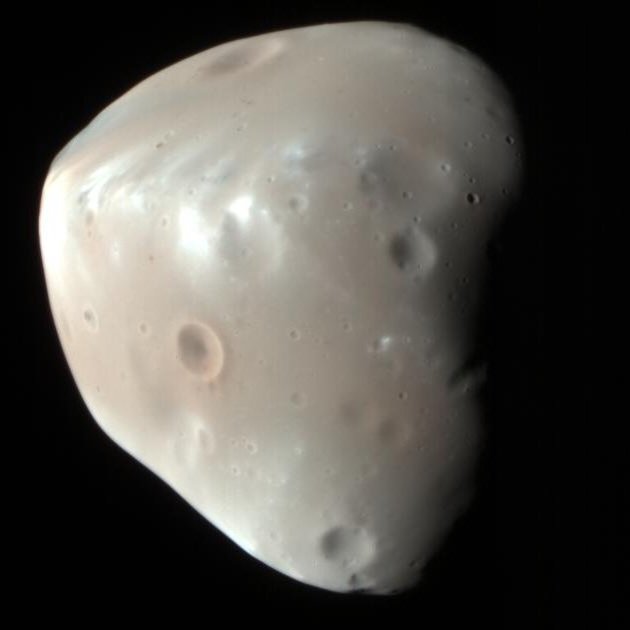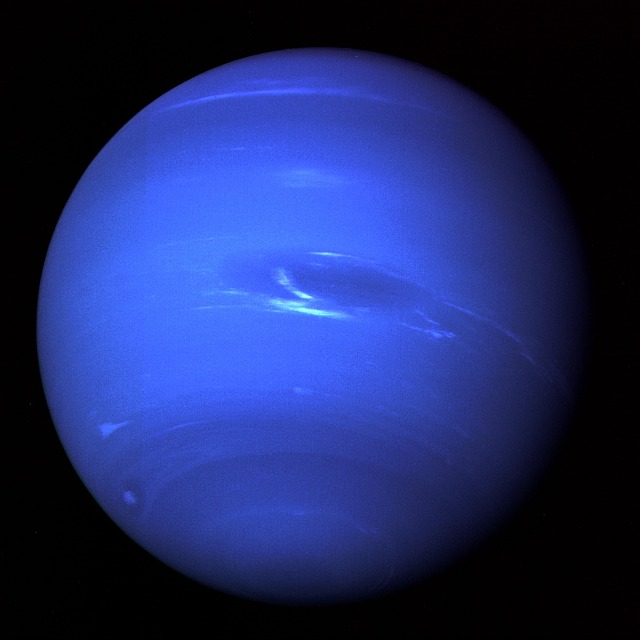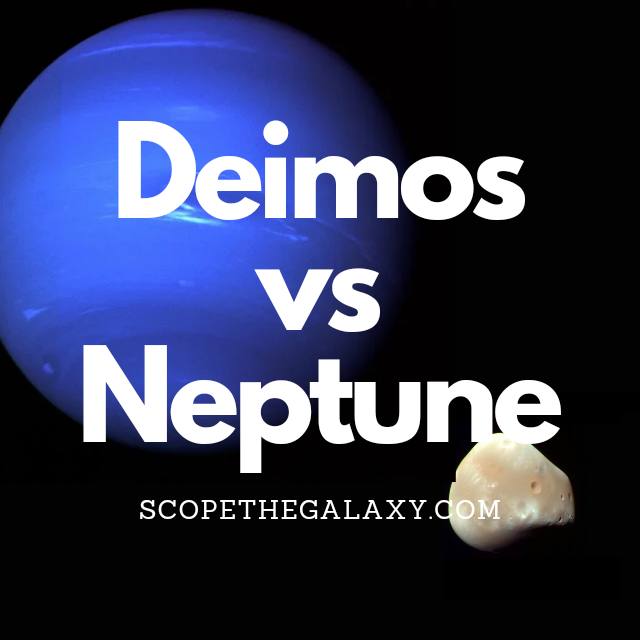*This post may contain affiliate links. This means we may make a commission if you purchase an item using one of our links*
The main differences between Deimos and Neptune are that Neptune is a gas based giant while Deimos is a natural satellite, Neptune is far bigger with a diameter of 49,244km while Deimos’ is 12.4km and Neptune has 14 other moons orbiting it while Deimos is one of 2 moons that orbits Mars.
There are various other differences between the two so, continue reading for a more detailed look at each body along with their similarities and differences below.
What Is The Moon Deimos?
Table of Contents

Deimos is the smaller and outermost of the two moons of Mars, named after the Greek God of dread and terror (the brother of Phobos). This satellite was also discovered by American astronomer Asaph Hall just five days before Phobos (12th August 1877).
Scientists like Johannes Kepler had put forward theories for the existence of these moons many years before they were discovered. Their calculations were based on the fact that the planets on either side (Earth and Jupiter) possessed one and four moons, respectively.
Still, none were discovered until the 19th century. One of the main reasons for this is that the tiny size of Phobos and Deimos, combined with an exceptionally close orbit to their planet, means that the glare of Mars often obscures our view of them.
Phobos measures just 15 x 12 x 11 km and completes an orbit of Mars once every 30 hours.
This tiny moon is also a heavily cratered landscape shaped by the impact of asteroid collisions over time. However, the material thrown up from these impacts doesn’t appear to have landed back on the moon’s surface as it usually would. This could be because the lack of gravity on Phobos allowed the ejected material into space.
The surface gravity on Deimos is just 0.003 m/s^2 (compared to 9.807 m/s^2 on Earth), which means the average gravitational pull of Deimos is only 0.003 m/s. With only 1/2500th of Earth’s gravity, you would need a tether to walk on this rocky moon, or every step would put you at risk of achieving escape velocity and launching yourself into space.
The composition of Deimos is similar to Phobos, suggesting that it might also be a captured asteroid. Its surface is very dark gray and has an albedo of around 0.07, meaning it reflects just 7% light (about half of the light Earth’s moon can reflect).
What Is The Planet Neptune?

Neptune is the 8th farthest planet from the Sun and ranks among the bigger planets in our solar system. As the 8th farthest planet from the Sun, it does take Neptune a very long time to complete 1 orbital around the Sun.
This takes 165 years to complete which in comparison to the 16 hour 1 full spin around the axis is a massive difference.
In regards to its composition, Neptune is mostly made up of a thick swath of water closer to the center, methane, ammonia, hydrogen and helium molded around its Earth sized core.
As a result of the excess amount of methane and the inclusion of another undiscovered element within the atmosphere, Neptune’s color is a far deeper blue than the likes Uranus, which also has an abundantly methane based atmosphere.
The planet is 49,244km in diameter, making it roughly 4 times Earth’s diameter Earth, and would allow around 57 Earths to fit inside it. This also makes Neptune the 4th largest planet in our solar system.
Neptune is very cold mostly down to its distance from the Sun, where its atmospheric temperature sits between -220 to -230 degrees Celsius. Its core is far hotter coming in at 5,100 degrees Celsius and is the very likely cause for the liquid water present within the planet
Subsequently, the erratic temperature and gaseous composition of Neptune, is what constitute towards its turbulent behavior.
In fact Neptune has the fasted winds in our solar system, producing some that eclipse speeds of 2,000km per hour. The fastest winds on Earth would only be a fifth of these speeds at most.
At this moment in time we have discovered 14 moons orbiting Neptune and have also observed 5 thinner rings surrounding the ice giant.
Similarities Between Deimos And Neptune
There are a few similarities that Neptune and Deimos share, which in this case includes the following:
- Both are part of the same solar system.
- Neither have tectonic plates.
- Both orbit another larger object.
Differences Between Deimos And Neptune
As for the differences between the two, they include the below.
- Deimos orbits Mars whilst Neptune only orbits the Sun.
- Neptune is a spherical shape while Deimos is not.
- Neptune has 14 moons orbiting it while Deimos has none.
- Neptune is an ice based gas giant planet whilst Deimos is a terrestrial based natural satellite.
- Neptune has a diameter of 49,244km whilst Deimos has a diameter of 12.4km.
- Deimos has no atmosphere whilst Neptune is composed of helium, hydrogen and methane.
- A day on Deimos takes 30 hours whilst a Neptune day takes 16 hours.
- It takes Deimos 30 hours to orbit Mars and the Sun in 687 days whilst Neptune orbits the Sun in 165 years.
- Deimos’ temperature ranges between -4 to -112 degrees Celsius whilst Neptune has an average temperature of -220 to -230 degrees Celsius.
- Neptune has an axial tilt of 28 degrees whilst Deimos’ axial tilt is closer to 0.
- Neptune’s density is 1.64 g/cm³ whilst Deimos density is 1.47 g/cm³.
- Neptune’s mass is 8.681 × 10^25 kg whilst Deimos’ mass is 1.4762 × 10^15 kg.
- Deimos’ gravitational strength is 0.003 m/s² whilst Neptune’s is 11.15 m/s².
- Deimos is tidally locked to Mars whilst Neptune is not tidally locked to any entity
- Neptune has a magnetosphere whilst Deimos has no magnetic field.
- Deimos has no core while Neptune has a hot central core.
- Neptune has 9 rings while Deimos has 0.
Summary
Neptune and Deimos share very few similarities, which would include them being a part of the same solar system and having no having tectonic activity but, they certainly have way more differences between themselves.
Whether it be in regards to mass, size, physical composition, orbital period, density and more they differ significantly, which is why Neptune looks and functions very distinctly from Deimos and vice versa.

